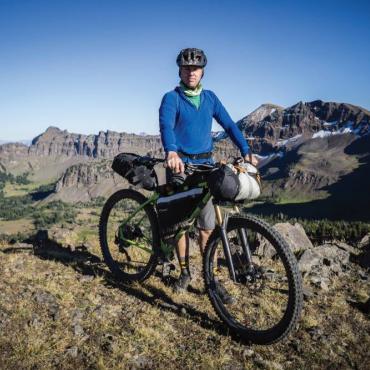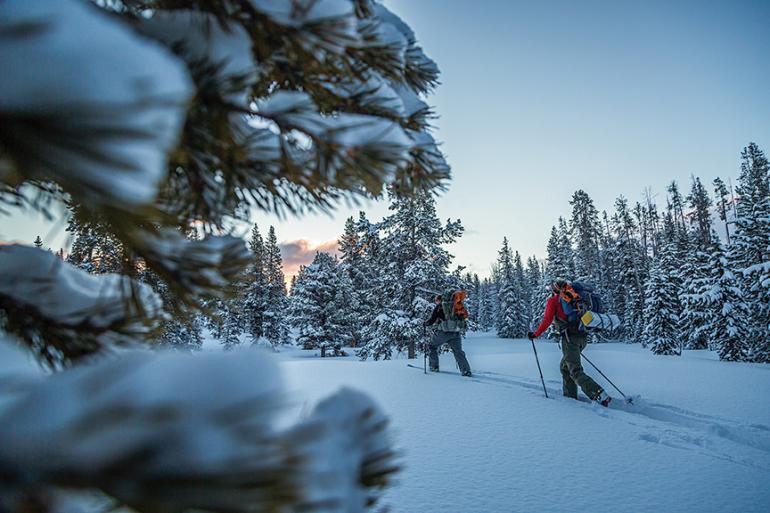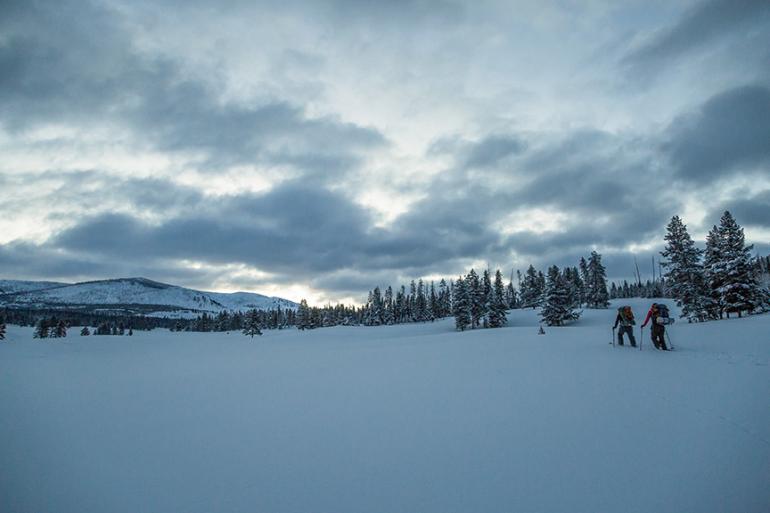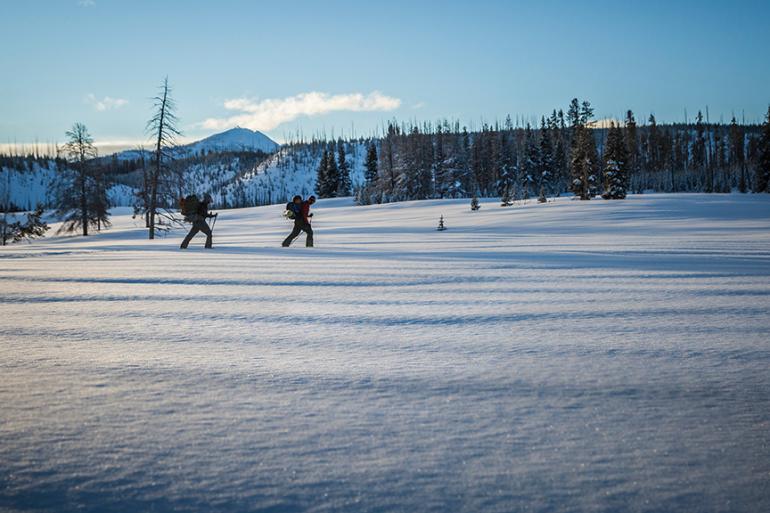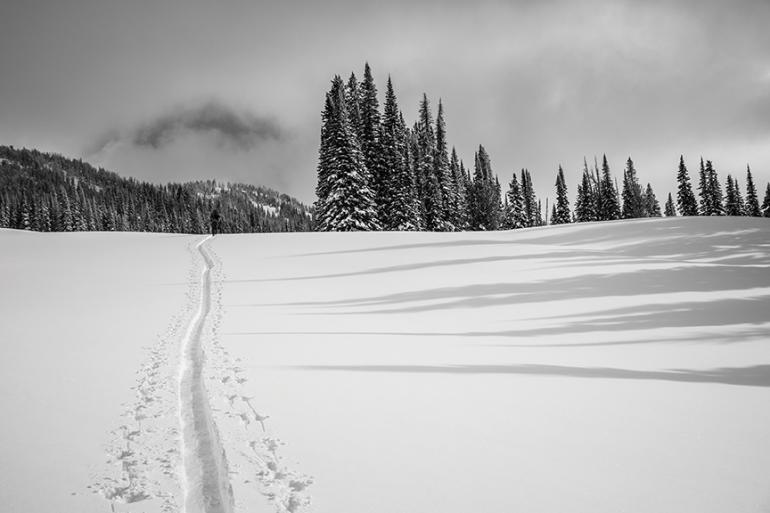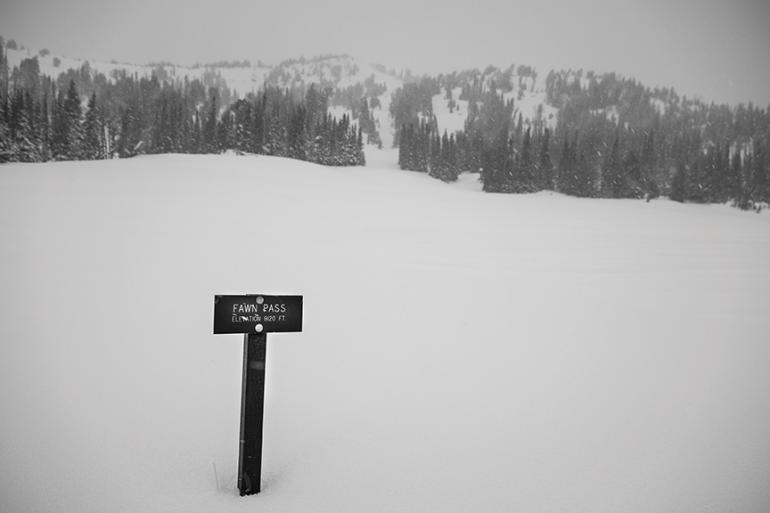Into the Great Wild Open
Up & over Fawn Pass.
Wolves.
At first I mistake them for any other variety of large mammaly creature that might be wandering around Yellowstone at 4:30am in the dead of winter. Their sheer height throws me off. You often hear about how big wolves are, but leaving it up to the imagination is an oversight—seeing them up close makes me fully appreciate the visual impact. And even at close proximity, our presence doesn’t seem to cause them any concern or unease. They are in control.
I’d seen their glowing eyes dart across the road in the early-morning darkness, as we missed the turn to the trailhead. The eyes of these giant canids—heading the same direction as we would be—are much, much harder to miss. We turned back at the next trailhead only to find two more along the road. As we now come eye to eye, they hop over the snowbank and down onto the dark valley floor below.
This is exhilarating—something everyone wants to see. And yet it’s not the ideal time or place. Our plan is to depart the trailhead in the predawn and ski across a large swath of Yellowstone National Park. We’d leave Hwy. 191 south of Big Sky, head up and over Fawn Pass, and drop into Mammoth the following day—a roughly 25-mile jaunt over the Gallatin Range through the winter wilderness.
This tour is not a new idea. In 1985, Montana photographer Tom Murphy skied solo from south to north through the Park for roughly 175 miles over the course of two weeks. And so while our little skip through the hills isn’t comparable, to us and most anyone else, it’s still a fantastic way to explore a wild piece of our own back yard at an incomparable time of year—wolves and all.
Their comfort in the blinding darkness was unnerving, and something that we would just have to shrug off before setting out to share Yellowstone with them for the next couple days. But in fact, the feeling of exposure was one that we would not rid ourselves of. It set the tone and kept us on our toes—we thought we might meet another pack around the corner or in the middle of the next frigid night outside. Or they’d be following us distantly in the beaten path that we created through the deep, freshly-fallen snow.
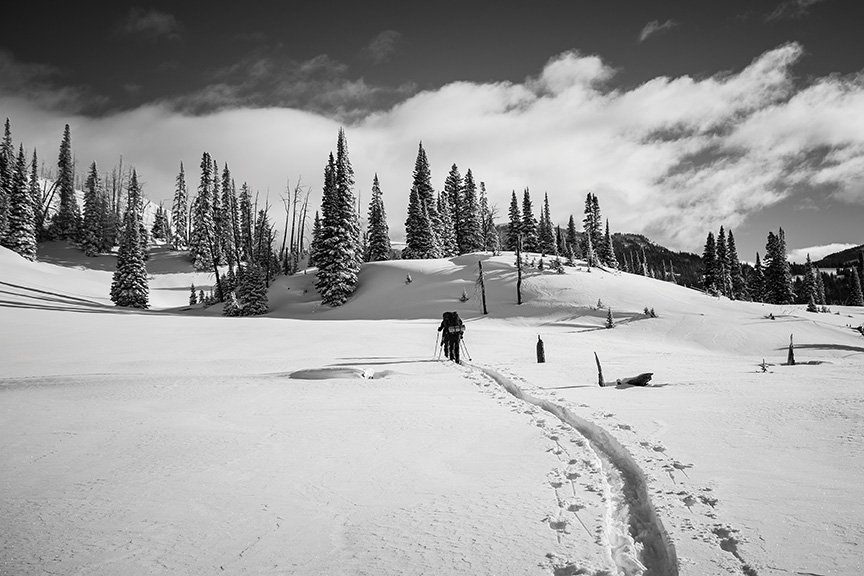
The Yellowstone wolf population is made up of roughly 11 packs with about 100 healthy wolves throughout the territory. Twenty years after reintroduction, wolf numbers are strong, although since 2007 there’s been a decline due to various diseases including mange, which reached epidemic numbers in 2009 and still exists on a much smaller scale. Healthy wolves have a natural aversion to attacking humans—it’s odd behavior reserved for a troubled animal that would be unprecedented and unlikely within the Park. Then again, unlikely does not mean impossible.
On skis at last with heavy packs on our backs, we skin up and over the snowbank and down onto the expansive valley floor below—just as the wolves had done moments prior. Breaking through ten inches of fresh snow and trying to find the way with diminutive headlamps, it’s clear that we’ll need to stay focused to find the way.
Less than 100 yards from the trailhead, there’s a braided river to cross—the Upper Gallatin. Meandering through the valley and breaking out into numerous channels, it’s unclear where the deepest water lies, but with some guessing and a bit of luck. we make our way across a snow bridge.
The scene is remarkable—the landscape is choked and in the remoteness of Yellowstone it feels like another world as we take off into the morning darkness into parts unknown.
With growing confidence, we follow Fan Creek and cover some distance in the frigid morning darkness, one step at a time—staying warm through motion, waiting on the sun to start the day. The sky is clear, the stars are out, and the moon shines bright over us as we move deeper into Yellowstone. The silence and cold are crisp and poignant. The sky goes from black to a deep blue and then light shows itself on the high mountains—peaks we will see from various perspectives throughout the journey—and for the first time we are able to see the area in a new light. Out in the fresh meadows leading up to Fawn Pass, the early-morning light creates long shadows and surreal colorscapes. Clean and crisp in the unadulterated landscape we move along under the changing winter sky.
Orange light reflects off of the snow and various wind features on the flawless landscape as each meadow carries us further from the last. We are out for a long winter stroll in one of the most remote and beautiful places conceivable. The sporadic clouds take on a reddish-orange hue on the horizon and soon after, the alpenglow presents itself on surrounding peaks as we head eastward up to the pass.
As afternoon approaches we climb toward Fawn Pass, and the weather starts to deteriorate along with our legs and a bit of our sanity. The tour has matured along with the day, and gone is the quick pace of the morning, with the fresh excitement of a new adventure. We are in the heart of the ascent now and with aching backs and legs, we will gradually climb up the pass with little relief.

We enter thick trees and move slowly, picking a careful route. Hours into the ascent, we look down to find that we are actually a bit too high and overshot the route slightly; but we make it down and find the sign noting “Fawn Pass.” It’s a relief to have made it here, but the feeling is brief and the celebration short.
Our intention is to find the Fawn Pass cabin. Although we were told it is out of service and not to be used, we figure it will be a good location to set up camp for the evening. A couple hours later, after descending off the east side of the pass, we manage to locate our camp as we come across the skeleton of this aging dwelling.
In the early part of the 20th century, Yellowstone Park built a series of backcountry patrol cabins in the wilderness of the Park. Each cabin was spaced roughly 16 miles apart—a day’s travel—so that rangers would have a place to spend a night as they were out working in the often deep and remote landscape. The cabins are accessible only by foot and in their time were a welcome sight for crews seeking reprieve from the elements. Today, all but about four of the cabins are out of use—either dilapidated beyond repair or simply boarded up and closed off.
The cabin is buried but the porch is still relatively open, so we dig out a spot next to the porch for the tent and start to prep a fire nearby. Somehow, in the deep snowpack, we’re able to build a worthy fire and warm up around the security of the flame as the night takes over Yellowstone once again.
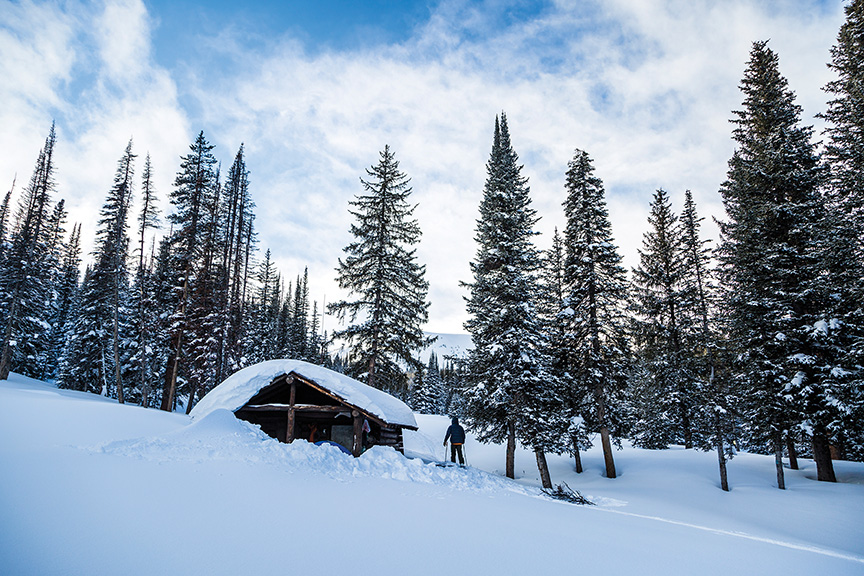
We wake before light and break camp to find that even more snow has fallen. The scene is remarkable—the landscape is choked and in the remoteness of Yellowstone it feels like another world as we take off into the morning darkness into parts unknown.
Exiting the forest, we ski down from the hills through countless meadows and follow along a steep creek that exits the hills in a vast drainage where two rivers will eventually merge. As we follow animal tracks and watch elk and bison, the wild landscape opens up and scale takes on a different and unknown meaning as we look out across the placid and seemingly infinite landscape.
We cross the Gardner River and work our way into the ever larger side-canyons of the Yellowstone. We pass Electric Peak, the tallest in the Gallatin Range at just shy of 11,000 feet, but we’re still many miles from Mammoth and the completion of our tour. Still, I can start to ignore my immediate discomfort long enough to appreciate where we are.
This is Yellowstone in winter—a scene most people will never witness—with big, wild landscapes where animals are free to roam and natural forces are visibly at play on a grand scale. This is a special place—preserved for anyone who cares to visit. We crossed a mountain range on skis, spent a cold winter night out under the sky, watched the sun rise over a mountain and shine flawlessly on an alpine meadow laden with new snow. We struggled a bit, suffered a bit, and laughed a bit. We came eye-to-eye with winter wolves.
That’s Yellowstone.

